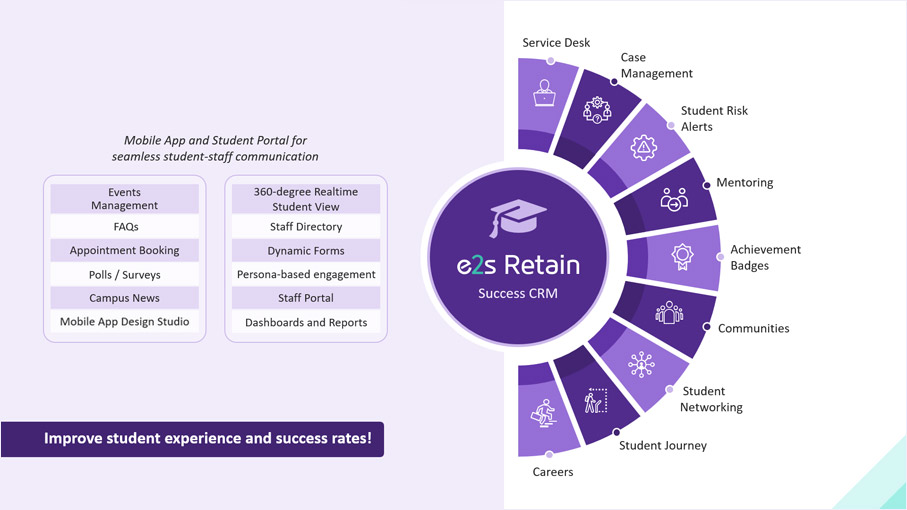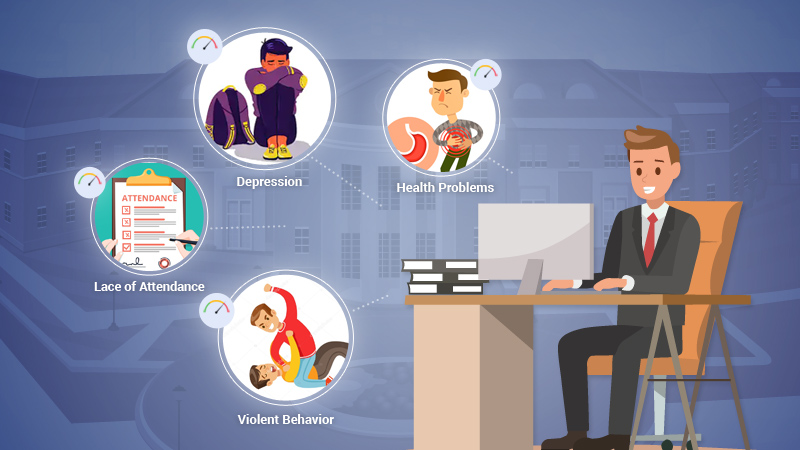The challenge of student retention has become an important concern for colleges and universities globally. The data below is for the United States, but student progression is an issue in most advanced countries in the world. As per the data submitted by various Higher Education institutions to the National Centre for Education Statistics (NCES), the total financial loss estimated across 1,295 US colleges and universities is nearly $33 billion per year. On average, a US college or university retains only 71% of its students year over year and loses $25.3 million every year as a result of student attrition. Student retention strategies have taken center stage today and increased focus on ways to enhance student success.
Early alert systems and student retention software facilitate faculty members or advisors to identify students at-risk and share that information amongst student support staff on the campus. A well-strategized, orchestrated and implemented Early Alert System should prevent students from slipping through the cracks by encouraging timely intervention. In reality, many uncoordinated real-time practices tend to hinder the efficiency of early-alert programs and effective steps towards student success.
So, let’s discuss the reasons that make early alert systems fall short and strategies to make them more efficient.
There are three main reasons for this pitfall
Lack of Clear Objectives
Many early-alert programs do not focus on identifying students who may be at risk. Once a potential at-risk student is identified, ‘what next?’ is the question. Faculty end up flagging a huge volume of potential risks and are overwhelmed with their own abilities to resolve them. Lack of clear and narrowed objectives is a reason that fizzles out early alert systems and thus hinders student success.
Lack of clear follow-up processes
Without clear instructions on how to respond to early alerts, advisors and staff respond in varying, uncoordinated ways, impacting the efficiency of the early alert system. A blueprint and standard operating procedure on how to respond to early alerts makes the system sustainable and eventually unshakeable. Student referrals, case management, and intervention mechanisms ought to be clearly defined, and tracking outcomes is imperative for eventual student success.
Lack of faculty participation
Faculty participation is fundamental and inevitable for a successful early alert system. It’s obvious that without faculty members’ continued involvement in their ongoing student referral, student support staff wouldn’t know which students are at risk or offer them care.
Now, can you improve faculty participation? Let us dig deeper.
Face-to-face meetings:
Administrative staff in charge of student affairs or student success need to conduct face-to-face meetings with faculty members. They need to be made aware of the challenges faced by students and how that affects institutional growth and brand equity. This will facilitate them to become more receptive to engaging themselves in the effective implementation of early alert systems. In short, getting their ‘buy-in’ is key to the success of an efficacious and constructive early alert program.
Taking a more sophisticated look at DFW rates:
Some faculty members perceive that DFW rates (students who receive a D, F, or Withdraw) are used to indicate that students’ lower performance is a way of finding fault with themselves. We need to level with the faculty members and make them realize that we are willing to delve deeper and do a root cause analysis for actual impediments to student success. Everyone involved in laying out the strategies for student success should first understand that an effective student retention plan is evolved by teamwork and not in any way a blame game. This open communication and transparency will make all stakeholders more receptive to Early Alert Systems.
Let the faculty members drive the early alert process
An early alert program has to be devised based on faculty input and preferences. The following questions are vital in helping us design the same
- Is the faculty member able to predict the final grades of the students based on their early performances?
- If yes, how early are they able to make an exact prediction?
- What would help students to perform better in the course?
- What resources would the students need to be more successful in the course?
The faculty should be the driving force in designing the Early Alert System to make it successful in the long term.
Follow up process and managing high volume of notifications
- A dedicated time should be solely allotted on a daily or weekly basis to early alert notification follow-up. This time can be used to read and prioritize notifications and reach out to students.
- Priority should be given to students with academic difficulty. Reaching out by phone or in person instead of email will encourage a meeting and facilitate counselling.
- A more aggressive approach should be devised to follow up with students who receive more than two academic difficulty alerts.
- Transfer students and freshmen should also be given priority in the follow-up process.
- The reporting process should be made as easy as possible for faculty members to manage their time efficiently and yet be part of student retention activities.
Let’s celebrate the positives
As it usually goes, a student who comes to school late is often criticized, whereas students who are on time to class are seldom celebrated.
Many lower-income students, and first-generation college students in particular, often endure doubts about belonging in college. Yet, while experts say that giving positive reinforcement could improve graduation rates, systematic methods of appreciating students remain rare. Early Alert Systems should also be Early Appreciating Systems, where students receive customized appreciation when they show marked progress in their academic participation and performance. Students love to receive positive feedback, and an effective Early Alert Systems should help students celebrate their progress on the journey towards student success.
Involve success coaches
Student success coaches are academic counsellors who are specialists in assessing the students’ needs. Any person with sound experience in educational counselling, leadership, psychology or a related field can be a success coach. Success coaches are not faculty counsellors or academic advisers. They advise students or refer them to a different department in the college for help. A good coach can help students sail through academic pitfalls, especially during that critical first semester. A little intervention can make a big difference between student success and failure.
Thinking of offering a success coaching program at your college? Here are a few tips:
- Cross-train your success coach. Coaches should have a sound knowledge of the available resources, services and the management structure of the college and be able to facilitate student help with tutoring centers, counsellors and academic advisers.
- Hire friendly individuals. Students will most likely discuss highly personal problems with these coaches. These professionals have to be skilled at making students feel at ease for these interactions to be successful.
- Get data experts involved. The success coaching results need to be tracked as this will help coaches frame strategies and understand what questions to ask students to help them complete their degrees.
With all the above said and done, we would have turned all the stones to improve student retention rates. In order to effectively capture student information, identify early alert situations, devise intervention programs, track progress and close the loop on student retention, needless to say we need sturdy processes and nimble software systems. In order for the Early Alert System to be successful, customized student touchpoints have to be precise and timely, data from college systems integrated in an expeditious manner, and the decision support dashboards dynamic and meaningful. Choosing an appropriate software system with modern, mobile-first architecture and designing business processes to support the system are key to plugging student attrition.
For a successful student retention program to be in place, it should be supported by a comprehensive student retention software with a student service desk for quick student referral, student-advisor-faculty meeting enabler, interim progress report for faculty members, integrated systems to feed student progress and attendance data, a 360 student view to present real-time progress, status, transactions of students.
Schedule a quick discussion with our team to see how e2s Retain can help you.

Engage2Serve Inc. is the creator of transformational cloud-based, mobile-first Student Lifecycle CRM products for student recruitment, student success and retention, and alumni engagement.


COMMENTS